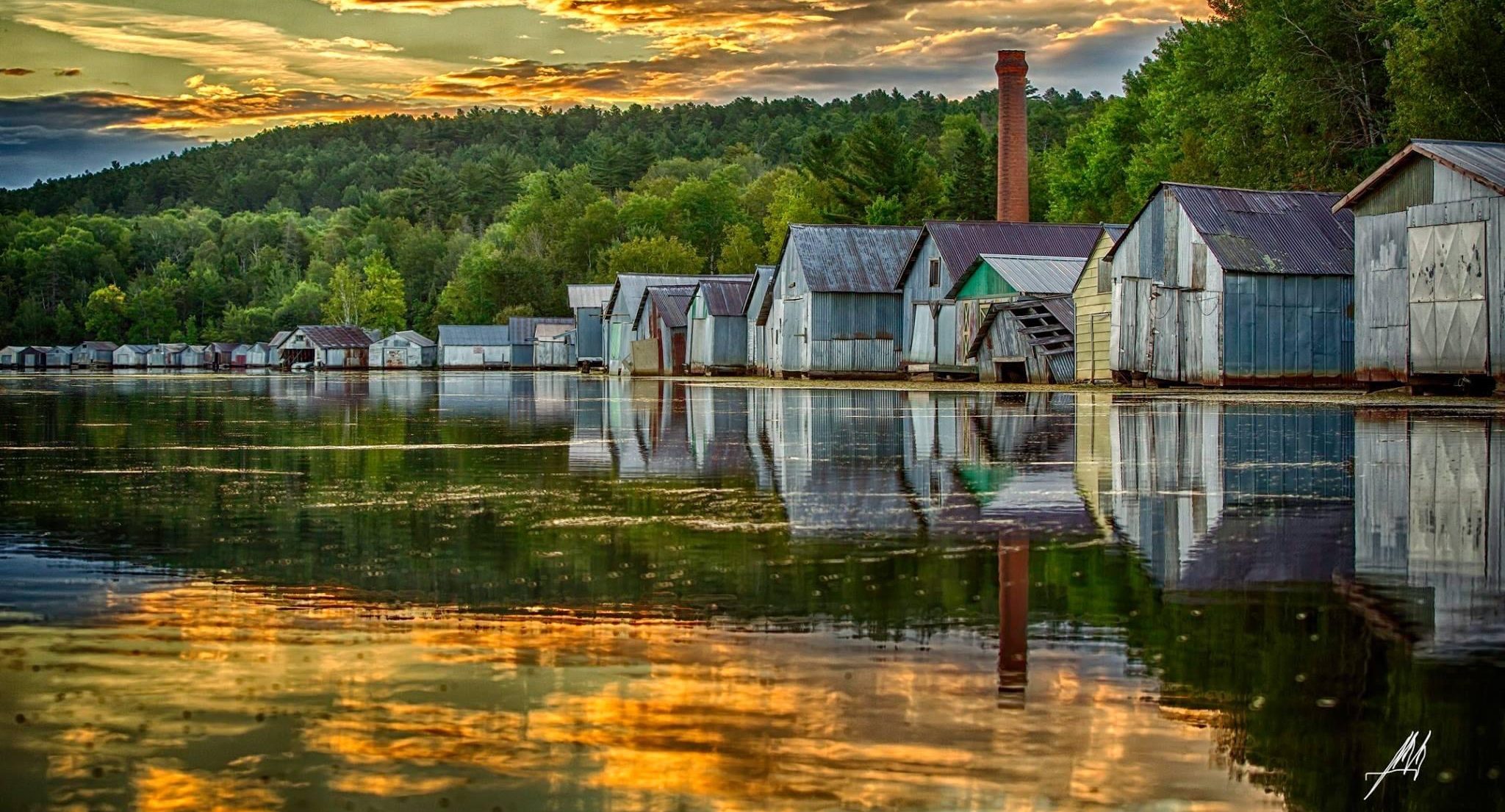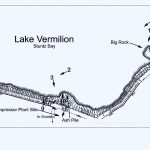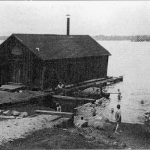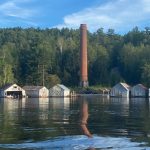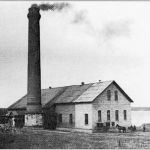Stuntz Bay Boathouse Historic District
Catch a glimpse of history along Stuntz Bay Boathouse Historic District on Lake Vermilion in the community of Soudan in Breitung Township. Together, they reveal Minnesota’s mining past. Most boathouses are rusty, ramshackle. One alone would attract little attention. Each one is a simple structure, framed by tamarack logs and covered in corrugated steel. But together, strung along Lake Vermilion’s south shore of Stuntz Bay, the 151 boathouses stretching for about two-thirds of a mile along the south shore of the bay, near the base of the hill that stands between the residential community of Soudan and Lake Vermilion, reveal the lives of the folks who built them. It’s a story of the area’s work-hard, play-hard past.
The Stuntz Bay boathouses are unique historic resources that have provided leisure and recreation opportunities for Soudan miners and their families for several generations. The boathouses allowed the mine workers to take advantage of the area’s natural resources and beauty, a benefit actively promoted by the Oliver Mining Company to improve employee job satisfaction, and became an important asset in the everyday life of the miners who helped the Soudan Iron Mine prosper and thrive. The architectural character of the boathouses, their vernacular building methods, and the sense of place provided by the natural landscape features– outcroppings, known locally as “Big Rock” and “Fisherman’s Dock”–also contribute to the district and have cultural importance. The ruins and smokestack of a compressor plant, and a boat ramp help illustrate the story of the community of Soudan.
History
Stuntz Bay is named for George Stuntz, a government land surveyor from Superior, Wisconsin who is credited as the first white man to “discover” iron ore in the Vermilion Range of northeastern Minnesota in 1865. Native Americans living on the shores of the lake certainly knew of the presence of the mineral—if not its value to the steel industry—but it was not until Stuntz showed samples of the ore to George C. Stone, Duluth city treasurer at the time and an aspiring investor, that Euro-Americans turned their attention to the resources of the area.
Stuntz and Stone then turned to Edward Breitung, a mining investor from Michigan, and work began at the Stone and Breitung pits, as the Soudan mine site initially was called. In 1875, Stone presented samples of iron ore from the Vermilion and Mesabi Ranges to Charlemagne Tower, a lawyer and land speculator from Philadelphia. The result was that Tower became willing to finance further iron exploration in both areas. The four men formed the Minnesota Iron Company.
By 1879, Tower decided to move forward and buy up the land that Stuntz said had the potential to produce the most valuable ore—the Vermilion Range— and Tower concentrated his investment in the area around what we now know as Soudan. Tower began acquiring land by hiring men to claim 160-acre parcels. Rather than establishing homesteads and making improvements, as the law required, the entrymen promptly sold the land back to Tower. Tower purchased additional land in the area until he owned over 20,000 acres by the end of 1882 and took leadership of the company. Charlemagne Tower’s Minnesota Iron Company began an open pit mine operation in 1882, and moved to underground mining by 1900 for safety reasons.
The Minnesota Iron Company built the first boathouse on Stuntz Bay in 1884 to shelter its steam launch, the Decora Tower. It was one of three buildings constructed by the company near the lake. The mine’s steam plant and air compressor, which provided power to the mining operation nearly a mile away, was built the same year. A pumphouse was also built near the shore of Lake Vermilion to pump drinking water over the hill from the lake to provide water to the mine and the community’s residences. Electricity was provided to the location in 1924 when the mine was electrified, and plumbing was run throughout the community in 1945.
The Minnesota Iron Company built blocks of houses in Breitung and Stone, two unincorporated communities known as “locations” that were established by mining companies throughout the Iron Range as residential enclaves for the miners and their families, that together came to be known as Soudan by the late 1880s. The houses, which were small, simply built, and uniform in appearance, were leased to mine workers. Many of the miners eventually were able to purchase their homes, but the lots remained under continuous control of the mining company. Soudan had become a “company town”.
In the 1890’s the Oliver Mining Company, known as “the Oliver”, purchased and managed the Minnesota Mining Company and the land around it, including Soudan. “The Oliver”, eventually associated with US Steel, presided over the mine and local community through most of the twentieth century, relying on the skill and stout backs of its miners laboring beneath the earth’s surface. In return, the Oliver provided a livable wage and affordable housing.
Boathouses are Constructed
A ”perk” that the Oliver offered senior miners was a lakeshore boathouse lot along company-owned Lake Vermilion shoreline as a reward for years of service. Lots were leased to the miners, but the boathouses were constructed and owned by individuals. Such rewards kept its workforce content, according to Denis Gardner, National Register Historian at the Minnesota Historical Society.
From the turn of the century through the 1950s, miners erected “wet” boathouses, which extend over the water, with tamarack logs cut on Oliver land and corrugated metal salvaged from the mine’s scrap pile. Because most of the buildings at the mine site were also clad with corrugated metal, it was a material that was familiar to the men and easily obtained. The construction of crib footings that support the wet ends of the boathouses was a technique probably borrowed from the mine, where cribs were used to brace the ceilings of drifts or contain piles of ore.
The boathouses were somewhat similar in design, with gable roofs, wood framing, and most sheathed in corrugated metal. Pedestrian doors were on the shore side, with boat doors on the lakeside. Nearby, the smokestack of the compressor building (removed ca. 1930) stood like a sentinel, surveying the surroundings.
Each boathouse sported a number — 1 through 151. Many also included nicknames and family names, some hand scrawled. A few boasted brightly-painted doors, or decorations like ducks, anchors, warnings. Inside, construction tended toward utilitarian, with little room on either side of the boat channel for more than tools. But today, among the winches, ropes and “ice-out” calendars are hints at lives of miners and their families.
The boathouses had an especially strong association with the men of the community, who built the structures and were the primary users of the boathouses. Oral history accounts tell of men gathering there to receive haircuts from each other, drink beer, play cards and make music. “It was a way of life. You worked at the mine, then you went hunting and fishing,” According to Denis Gardner, National Register Historian at the Minnesota Historical Society.
The boathouses were used for other recreation in addition to fishing and boating. Children swam and fished in the area, The mining company paid for electricity until shortly after the mine closed, and the women of the community would congregate at the boathouses to do laundry–especially ironing– taking advantage of the free electrical power and the opportunity for companionship while doing their chores. In the earlier years, before 1924, there was no electricity in their homes in Soudan but there was electricity to the boathouses.
From 1901 until the end of active mining in 1962, the Soudan Mine was owned by the United States Steel Corporation’s Oliver Iron Mining division. In 1965 US Steel donated the property to the State of Minnesota to use for educational purposes. The boathouses largely remain family-owned inholdings within the Lake Vermilion-Soudan Underground Mine State Park with the owners pay a yearly lease fee to the state for the land on which the boathouse sits.
Stuntz Bay Association
The formation of the Stuntz Bay Association in the spring of 1962 marked an important event in the history of the boathouses and the town of Soudan. The Association was founded to oversee the collective management of the boathouse properties in anticipation of the December 1962 closing of the Soudan mine and the subsequent granting of the mine property and adjacent land to the State of Minnesota.
The Association’s membership was made up mostly of boathouse owners and their immediate families who valued the structures and the way of life they had enjoyed on the lake. The formation of the Association marked a significant shift in the local mentality as individuals became responsible for the care and maintenance of the boathouses and the lifestyle they symbolized, contrasting with Oliver’s decades of benevolent control. The Association has remained active for over sixty years, helping to maintain the character and condition of the boathouses and the surrounding area.
Initiation of the Stuntz Bay boathouses nomination to the National Register of Historic Places was made by the Stuntz Bay Association in 2006. Members conducted a local fund raising campaign to secure funding for the engagement of a historian to conduct the research and prepare the nomination.
The Stuntz Bay Boathouse Historic District was listed in the National Register of Historic Places in 2007. They were nominated for illustrating the personal lives of the miners and vernacular metal architecture. Add the nomination to the National Register of Historic Places. LINK https://npgallery.nps.gov/GetAsset/dc2338c6-6a72-4dcf-9b98-5f9c49de027c
Sources:
Lee Bloomquist, “Group Wants to Keep the Past Afloat,” Duluth; Denis P. Gardner, Minnesota Historical Society National Register Historian, “Landmarks-Stuntz Bay Boathouse Historic District”.
Erin Hanafin Berg and Charlene Roise, “Stuntz Bay Boathouse Historic District,” January 2007, National Register of Historic Places Registration Form, State Historic Preservation Office, Department of Administration.

